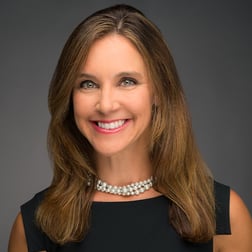symplr CMO Kristin Russel on Healthcare Operations and Technology

The symplr Compass Survey took the temperature of healthcare technology leaders, all members of the College of Healthcare Information Management Executives (CHIME), finding them motivated to digitally transform their healthcare operations despite financial pressure, widespread healthcare workforce problems, and other challenges.
 Next, we asked symplr's top executives to share their outlook for healthcare operations and technology.
Next, we asked symplr's top executives to share their outlook for healthcare operations and technology.
symplr Chief Marketing Officer Kristin Russel's responses and reactions follow.
Get your copy of the symplr Compass Survey
How do you define healthcare operations—the "other bucket?"
KR: Healthcare operations is a term that in some ways we are creating here at symplr. We wanted a way to talk about uncategorized activities within healthcare information technology (IT), exclusive of enterprise resource management (ERM), electronic health records (EHR), and revenue cycle management (RCM). The healthcare operations functions sit strategically at the nexus of ERM, EHR, and RCM and account for more than half of a healthcare organization’s other spend. The activities within healthcare operations include, for example, workforce management, provider data management, spend and value analysis, analytics, and quality and safety. Anecdotally, I’ve heard hospital CIOs refer to this area of spend as their “other bucket”—not the EHR, not the ERM, not the RCM, but everything else.
At symplr, we saw an opportunity to collate these mission-critical activities and create an enterprise category called healthcare operations. This new category doesn’t only apply to hospitals or integrated delivery networks but includes payers, skilled nursing facilities, long-term acute care systems … ultimately any healthcare organization affiliated with the provision of patient care.
What are 3 customer trends you’re keeping an eye on today?
KR:
- Financial health: According to a Kaufman, Hall & Associates survey, 53% of hospitals are projected to be operating with negative margins, so about half of our customers are facing this fiscal reality. In this moment, we are partnering closely with our customers to support them with solutions that fine-tune their healthcare operations to mine value, make processes more efficient, and retain their clinicians.
- Labor shortages and workforce management: We saw clinician labor shortages during and post-pandemic, and according to the Bureau of Labor Statistics, overall healthcare employment is expected to grow 15% over the next decade and yet the workforce itself is shrinking. This has created challenges for healthcare organizations; however, tools within our symplr Workforce solution help address clinician labor shortages and improve provider availability—and perhaps even more importantly, make clinicians’ and healthcare staff’s lives easier and stem administrative frustration.
- Consumerization of healthcare: We help our healthcare customers find the best ways to gain and keep patients. They’ve come to symplr asking for help to make it easy for patients to find a doctor in their network. Consumers seek digital healthcare experiences that feel more like the experiences they enjoy within their digital apps such as Amazon, Google, YouTube. They want to search for, find, and schedule the appointment with the right specialist or physician seamlessly and in minutes. And at the same time, health systems are looking for ways to enhance and connect the consumer experience to enable coordinated provider data management that supports network growth and reduces data management resources. Here at symplr, we help our healthcare customers find the best ways to gain and keep patients while ensuring their providers are credentialed and scheduled.
The symplr Compass survey shows that 60% of healthcare organizations use 50+ systems for healthcare operations alone. How can symplr help?
KR: Some 88% of the chief IT executives at 132 leading healthcare organizations have said that working with disparate technologies complicates their job. Most of them—60%—report using 50-500 solutions for healthcare operations alone. That adds up to wasted resources, potential compliance issues, unnecessary administrative burdens on providers and staff, and more issues that take healthcare organizations’ eye off the goal of delivering excellent patient care. symplr provides one system to manage all areas of healthcare operations and the back office. In fact, no healthcare technology company is investing as much as symplr in healthcare operations, to help in this way. We can be the one vendor partner for healthcare organizations’ operational needs.
What are 3 symplr accomplishments from this year you're proud of?
KR: We took on a lot this year. We continued to round out our portfolio of offerings for our customers. For example, the acquisitions of GreenLight Medical and Midas helped us incorporate a new way of thinking about spend and quality in our vision for one connected healthcare operations system. Midas brings unmatched capabilities in managing risk, quality, and compliance to improve safety and outcomes. GreenLight Medical [now symplr Spend] brings our customers the evidence, safety, regulatory, recall, financial, spend analytics, and contract data they need to rigorously evaluate medical supplies, capital equipment, med-surg, and purchased services.
We also decided this year to invest not just in acquiring the organizations, but in how we enable those ultimate connections to occur. To do this, we looked at our R&D and our investment in what we call the SAI [Software-as-a-service (SaaS) Acceleration Initiative]. How do we fund the movement of all our solutions into the cloud and also drive connected workflows? We also looked at a common UI/UX in the product area and invested in improvements there. We decided that in addition to being the single healthcare operations vendor our customers need, we also want to give our users a common experience and ultimate ease of use.
I think the final accomplishment, as an organization, is that we’re laser-focused on delivering not only great service and great products, but a best-in-class experience that's aligned with our customers. We have stood up a voice of industry program this year and we have an Executive Customer Council (ECC) that helps us understand how we're truly doing in the industry and our customer teams have been hard at work envisioning how we can better service our healthcare organization partners.
What can symplr customers expect in the coming year?
KR: Customers can expect to see us taking big strides in areas like service, delivery, and how we set our customers up for success and engage with them. We're working hard at communicating with our customers and with our prospects about our vision, and specifically how our advancements, apply to them in areas where they may not even know we excel.
We'll also host our first Healthcare Operations Summit with ECC members and prospects and customers from across the healthcare industry to hone the voice of healthcare operations.
Finally, now that symplr is firmly cemented in the core of the healthcare IT ecosystem, we’ll amplify to the healthcare technology world what that position means for improved healthcare overall. Our mission and unwavering belief in our purpose drive us to simplify healthcare operations and improve outcomes for patients, providers, staff, and healthcare organizations of all types.

